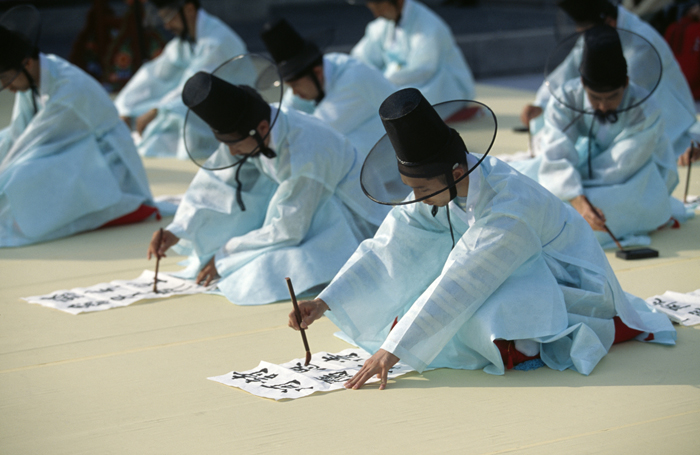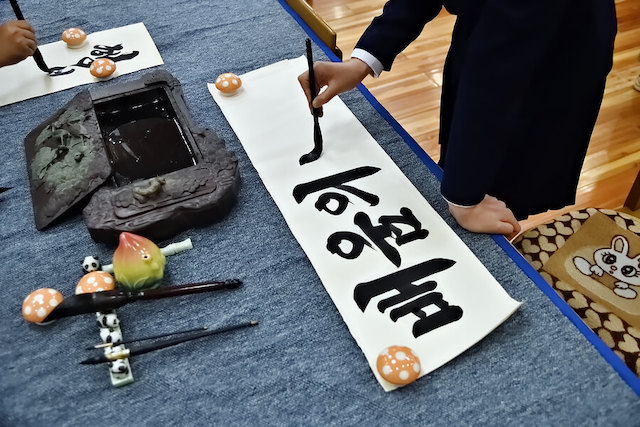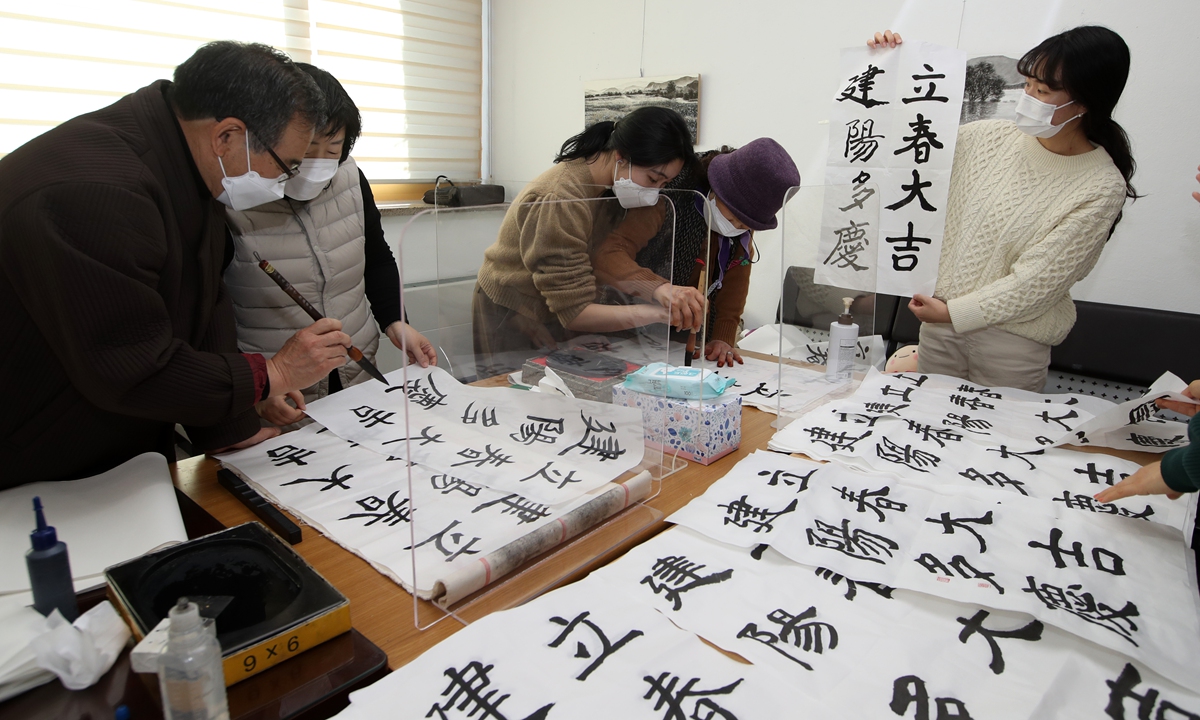Discovering the Art of Calligraphy in South Korea
Jan 7, 2025 | By Piz za
Korean calligraphy, known as “Seoye” (서예), stands as a testament to the rich cultural heritage and artistic expression of Korea. This ancient art form, which involves the artistic writing of both Hanja (Chinese logographs) and Hangul (the Korean native alphabet), transcends mere communication to become a profound medium of aesthetic and spiritual expression. As we delve into the world of Korean calligraphy, we uncover its historical roots, its evolution through different dynasties, and its contemporary significance in South Korea.
Historical Context
The origins of Korean calligraphy can be traced back to the early Three Kingdoms Period (57 BC – 668 AD), when Korea adopted Classical Chinese as a written language (Path to Korean). During this time, calligraphy was not only a scholarly pursuit but also a significant cultural import from China. The Goryeo (918–1392) and Joseon (1392–1897) dynasties further developed this art form, with calligraphy being practiced primarily in Hanja. Utilitarian objects from these periods often featured calligraphic inscriptions, demonstrating the integration of calligraphy into everyday life (Wikipedia).

The introduction of Hangul in the 15th century by King Sejong the Great marked a pivotal moment in Korean calligraphy. While Hanja remained dominant for official and scholarly writings, Hangul began to influence the art form, offering a unique script that was both phonetic and accessible to the Korean people (90 Day Korean).
Evolution and Influence
The 20th century brought significant changes to Korean calligraphy, particularly during and after the Japanese occupation (1910-1945). During this period, Korean calligraphy began to incorporate elements of Japanese calligraphy, reflecting the complex cultural exchanges of the time. However, the post-World War II era saw a decisive shift towards Hangul, driven by governmental efforts to replace Chinese characters with the native script (Britannica).

This transition facilitated the development of modern Korean calligraphy, which now predominantly features Hangul. This evolution reflects a broader cultural movement towards embracing Korean identity and heritage, distinguishing it from its Chinese and Japanese counterparts (90 Day Korean).
Artistic and Cultural Significance
Korean calligraphy is more than just an art form; it serves as a bridge connecting traditional culture with contemporary creative expression. The practice involves meticulous strokes of ink on rice paper, where each character is crafted to convey not only meaning but also emotion and aesthetic beauty (Moments Log).

The art of calligraphy embodies a harmonious blend of aesthetics, spirituality, and historical tradition. It is a cherished Korean art form that imparts the artist’s emotions while illustrating the strength, purity, and sempiternity of ancient tradition (Hallyuism). This spiritual dimension of calligraphy is often likened to a dance, where the strokes of Hangul characters come together in a mesmerizing display of artistic expression (Seoul Korean).
Contemporary Relevance
In contemporary South Korea, calligraphy continues to thrive as a dynamic art form that resonates with both traditional and modern sensibilities. It serves as a medium for artists to explore new creative possibilities while remaining rooted in the cultural heritage of Korea. The practice of calligraphy today reflects a visual art that showcases Korean culture through Hangul, rather than Hanja, marking a significant departure from its historical roots (90 Day Korean).

Calligraphy in South Korea is celebrated through various exhibitions, workshops, and cultural festivals, drawing enthusiasts and practitioners from around the world. This ongoing engagement with calligraphy highlights its enduring appeal and its role as a vital component of Korean cultural identity (Moments Log).
Must-Visit
- Seoul Calligraphy Art Museum
Located within the Seoul Arts Center, this museum showcases both traditional and contemporary calligraphy works, along with specialized exhibitions focusing on Hangul calligraphy. - Andong Hahoe Folk Village
A UNESCO World Heritage site where you can immerse yourself in traditional Korean culture and witness live demonstrations of classical calligraphy techniques. - Jeonju Hanok Village
This historic village is the perfect place to attend calligraphy workshops and enjoy a hands-on experience with traditional Korean arts. - Korea House, Seoul
A cultural hub offering exhibitions and performances, including displays of Korean calligraphy that highlight its artistic and spiritual essence. - National Museum of Korea, Seoul
Home to an extensive collection of calligraphy pieces from the Goryeo and Joseon dynasties, providing deep insights into the historical evolution of the art.
Exploring the art of Korean calligraphy allows you to connect with a rich cultural heritage while appreciating the intricate blend of history and artistic expression. These destinations promise unforgettable memories and a deeper understanding of one of Korea’s most treasured traditions.
Conclusion
Korean calligraphy, with its rich historical roots and evolving artistic expressions, continues to be a significant cultural and artistic tradition in South Korea. From its early adoption of Chinese logographs to its modern manifestation through Hangul, calligraphy embodies the spirit of Korean culture and artistic innovation. As a bridge between the past and the present, Korean calligraphy remains an inspiring and vital art form that continues to captivate and connect people across generations.
Related Blogs

India vs New Zealand: A Traveler’s Perspective on Two Unique Destinations
India vs New Zealand are two destinations that offer contrasting yet equally mesmerizing experiences. India vs New Zealand comparisons often highlight India’s centuries-old traditions, bustling bazaars, and architectural marvels versus New Zealand’s breathtaking natural landscapes and adrenaline-pumping adventures. Whether you’re a culture enthusiast, nature lover, or thrill-seeker, this guide will help you explore the best […]

Barbastro Barcelona: A Journey Through Spain’s Hidden Gems
Spain is a treasure trove of culture, history, and breathtaking landscapes. Two destinations that encapsulate the country’s charm are Barbastro Barcelona. While Barcelona is renowned for its vibrant city life and iconic architecture, Barbastro offers a quieter, more traditional Spanish experience nestled in the heart of the Somontano wine region. Together, they create the perfect […]

The Complete Guide to the Carry On Cast: Past, Present, and Future
The Carry On films stand as a cornerstone of British cinema, delivering decades of laughter and unforgettable characters. This iconic comedy franchise, spanning over 30 years, combined slapstick humor, clever wordplay, and a talented ensemble cast that became household names. This guide explores the history of the Carry On cast, their contributions to the franchise, […]

Exploring Austria’s Iconic Opera Houses
Austria, a nation steeped in a rich cultural heritage, stands as a beacon of classical music and artistic excellence. Among its most revered cultural institutions are its opera houses, which serve as both architectural marvels and stages for world-class performances. This report delves into the history, architecture, notable performances, and cultural significance of Austria’s iconic […]

Exploring the Distinctive Andean Music of Bolivia
The Andean music of Bolivia is a vibrant and integral part of the country’s cultural tapestry, deeply rooted in the traditions and spiritual practices of the Andean peoples. This genre of music is not only a form of artistic expression but also a medium through which the stories, legends, and historical narratives of the Aymara […]

Learning About the Carnival Culture in Rio de Janeiro, Brazil
The Rio de Janeiro Carnival, often heralded as the world’s largest and most famous carnival celebration, is a vibrant showcase of Brazilian culture, history, and community spirit. This annual event, which draws millions of participants and spectators from around the globe, is a testament to Brazil’s rich cultural heritage and its capacity for joyous celebration. […]

Mastering Mozzarella: A Taste of Italy
Mozzarella, a semi-soft cheese originating from Italy, is cherished for its creamy texture and mild flavor. Traditionally crafted from buffalo milk, it also finds a popular variant made from cow’s milk. This cheese is not just a culinary staple but a cultural icon, deeply embedded in Italian society and cuisine. Its high moisture content contributes […]

Discovering the Art of Calligraphy in South Korea
Korean calligraphy, known as “Seoye” (서예), stands as a testament to the rich cultural heritage and artistic expression of Korea. This ancient art form, which involves the artistic writing of both Hanja (Chinese logographs) and Hangul (the Korean native alphabet), transcends mere communication to become a profound medium of aesthetic and spiritual expression. As we […]

Scotland’s Tartan: A History of Highland Dress
Tartan, with its vibrant patterns and historical richness, is one of Scotland’s most iconic symbols. It is inextricably linked to the kilt and the national dress of Scotland, embodying both cultural heritage and identity. This detailed report delves into the origins, evolution, and cultural significance of tartan and Highland dress, exploring how this textile has […]

Tribal Arts of Papua New Guinea: A Unique Heritage
Papua New Guinea (PNG) is a nation marked by its remarkable cultural diversity, with over 800 distinct tribes, each possessing its own language and customs. This diversity is vividly expressed through the tribal arts, which are not only a testament to the rich heritage of the indigenous people but also serve as a living tapestry […]

